 Biksthang, situated in West Sikkim, is a small picturesque hamlet. It is the abode of scenic landscapes and majestic towering mountains. Located at a distance of 119 kilometres from Gangtok, it is also referred as Chuchen and Mangalbaray. The place offers a spectacular view of Mt. Kanchenjungha. The place has lately emerged as a cherished tourist destination dotted with exquisite natural beauty. Biksthang is adorned with wondrous serenity and tranquillity. Nestled at an altitude of 4200 feet, the exotic birds and gliding clouds make the place an excellent escape from the hectic city life.
Biksthang, situated in West Sikkim, is a small picturesque hamlet. It is the abode of scenic landscapes and majestic towering mountains. Located at a distance of 119 kilometres from Gangtok, it is also referred as Chuchen and Mangalbaray. The place offers a spectacular view of Mt. Kanchenjungha. The place has lately emerged as a cherished tourist destination dotted with exquisite natural beauty. Biksthang is adorned with wondrous serenity and tranquillity. Nestled at an altitude of 4200 feet, the exotic birds and gliding clouds make the place an excellent escape from the hectic city life.
History of Biksthang
According to the folklores, the name of the place has been derived from the Lepcha or Monree word `bik mon` which refers to the place where a tiger ate a cow. However the Lhopos or Bhutias claim that `biks thang` originally mean a place with a wide variety of special stones. Previously the region was also known as Mangbir which mean the place where millet is grown. Officially the place is called as Tsochen (Chuchen) which means Big Lake.
Tourism in Biksthang
 Biksthang is situated near Pelling and the tourists at Biksthang can easily access the various tourist sites of Pelling. Pelling hosts a number of monasteries such as Pemayangste Monastery, Tashiding Monastery, Sanga Choeling Monastery and Dubdi Monastery. The magnificent Khangchendzonga Falls is located close to Biksthang and is an attractive tourist spot. Temi Tea Garden and Shinshore Bridge are other attractions of Biksthang. It is a paradise for bird watchers and is characterized by pleasant climate and pristine wilderness.
Biksthang is situated near Pelling and the tourists at Biksthang can easily access the various tourist sites of Pelling. Pelling hosts a number of monasteries such as Pemayangste Monastery, Tashiding Monastery, Sanga Choeling Monastery and Dubdi Monastery. The magnificent Khangchendzonga Falls is located close to Biksthang and is an attractive tourist spot. Temi Tea Garden and Shinshore Bridge are other attractions of Biksthang. It is a paradise for bird watchers and is characterized by pleasant climate and pristine wilderness.
Tourists at Biksthang can also visit the nearby Rinchenpong which is another famed tourist attraction of Sikkim. There Poison Pokhri or Poison Lake is a must visit spot for the tourists. A stony staircase opposite to the pond leads to the forest trail which ultimately reaches to Rinchenpong Monastery. Rahu Ney caves and Lhentse monastery are also located near Biksthang and the areas are perfect for horse riding. River rafting and boating at the nearby dam is also enjoyable at Biksthang. The resorts at Biksthang also organize village tours in the surrounding areas where the tourists can explore the amazing lifestyles of villages.
Visiting Information
Biksthang can be visited all throughout the year however the period from October to February is ideal for having the best views of Mt. Kanchenjungha. Biksthang is located between Jorethang and Legship and is about 124 kilometres away from Bagdogra airport. New Jalpaiguri Railway Station is the nearest railhead which is located at a distance of 120 kilometres from Biksthang. The place is also well connected by roadways and drives from Siliguri or Gangtok are quite convenient and scenic. Comfortable accommodation facilities are available at Biksthang.



















